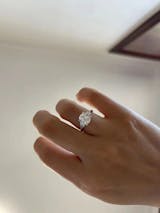HPHT VS. CVD LAB GROWN DIAMONDS
Share
Spoiler: They’re Both Real Diamonds – But Their Origin Stories Are Wildly Different!
The Dazzling Resumes of HPHT and CVD
HPHT (High-Pressure High-Temperature Method)
Specialty: Recreating Mother Earth's “diamond factory” but with a speed boost!
Birth Story:
Carbon element + Extreme pressure (≈ three elephants standing on a postage stamp (🐘🐘🐘)
Fiery temperatures (1400°C, hotter than lava 🔥)
With the help of metal catalysts
= A few weeks to create sparkling diamonds!
The queen of cost-effectiveness for small carats with high colour grades! 💎
Specialising in 1-2 carats, D-E colour as pure as snow ❄️
Budget-friendly, making diamond rings easily attainable!

CVD (Chemical Vapour Deposition Method)
Specialty: “Growing” diamond frost on glass, full of technological flair!
Birth Story:
Using a diamond “seed” (as thin as a credit card 💳) as a canvas,
Injecting carbon gas (like methane)
Microwave activation (with lightning effects ⚡)
= Carbon atoms stack like snowflakes, forming diamonds.
The ultimate presence of flawless large carats! 👑
Easily produces 3 carats+, VVS clarity that is transparent and flawless ✨
For those pursuing “carat freedom”, wearing one instantly makes you the centre of attention on the red carpet!

The Great Debate: Which Method Makes “Better” Diamonds?
Let’s settle this with a TikTok-style face-off:
| Category | HPHT | CVD |
|---|---|---|
| Color | Natural high grades (D-F) | May need a HPHT spa day to whiten |
| Clarity | Tiny metal flecks possible | Usually cleaner, fewer flaws |
| Shape | Best for classic cuts (round, etc) | Great for fancy shapes (oval, pear) |
| Speed | Slow cooker (weeks) | 3D printer (months) |
| Sustainability | Energy-hungry | Lower carbon footprint |
| Carat Sweet Spot | 1-2 carats | 3+ carats |
| Price Hack | D-E color (budget-friendly!) | Pay extra for untreated CVD (no color tweaks!) |


Goddess-Level Buying Guide: Locking in Your Diamond Based on Needs
Choose HPHT if you…
Adore D-F top-tier whites and refuse post-production beauty filters
Have a limited budget but seek “transparent little rock candies”
Choose CVD if you…
Are obsessed with large carats, believing “the bigger, the better”
Demand clarity, with no room for even the slightest imperfection
💡Tip: Just be aware that CVD diamonds can vary in colour treatment; untreated diamonds are more stable in quality and tend to be pricier than those with colour enhancements.

Goddess Soul Searching Questions
“Transparent small carat enthusiasts” vs “Lavish large carat devotees”, which side are you on?
Would you be willing to spend extra for “untreated diamonds”?
P.S. Still confused? Drop a comment – we’ll geek out together!




